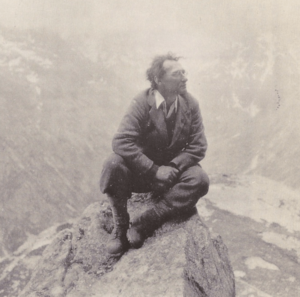I. A. Richards facts for kids
Quick facts for kids
I. A. Richards
|
|
|---|---|

I. A. Richards in the Alps c. 1930
|
|
| Born | Ivor Armstrong Richards 26 February 1893 Sandbach, Cheshire, England |
| Died | 7 September 1979 (aged 86) Cambridge, England |
| Occupation | Educator |
| Alma mater | Magdalene College, Cambridge |
| Period | 20th century |
| Spouse |
Dorothy Pilley Richards
(m. 1926) |
Ivor Armstrong Richards (born February 26, 1893 – died September 7, 1979), known as I. A. Richards, was an English teacher, literary critic, and poet. He helped create a new way of studying literature called New Criticism. This approach focused on looking very closely at a text, especially poetry, to understand how it worked on its own.
Richards' important ideas for New Criticism can be found in his books. These include The Meaning of Meaning (1923), which he wrote with C. K. Ogden, Principles of Literary Criticism (1924), Practical Criticism (1929), and The Philosophy of Rhetoric (1936).
Contents
About I. A. Richards
Early Life and Education
I. A. Richards was born in Sandbach, England. He went to Clifton College and then to Magdalene College, Cambridge. At Cambridge, he studied philosophy, not literature.
He believed that studying literature should not be done alone. Instead, it should be studied with other related subjects. These subjects could be philosophy, psychology, or rhetoric (the art of speaking or writing effectively).
Teaching Career and Travels
Richards started teaching at Cambridge in 1922. At first, he was a part-time teacher. The university did not pay him a salary for teaching English literature. This was a new subject back then. Instead, students paid him directly for his lessons.
In 1926, he got a permanent job as a university lecturer. He also traveled to China, teaching at Tsinghua University in Beijing for two years. He also directed the Orthological Institute of China for three years.
In 1939, he moved to the United States. He taught at Harvard University until he retired in 1963. He then returned to Cambridge, England, where he lived until he passed away five years later.
Personal Life
In 1926, Richards married Dorothy Pilley. They met while mountain climbing in Wales. Dorothy passed away in 1986.
Richards' Key Ideas
Working with C. K. Ogden
I. A. Richards worked with C. K. Ogden, a linguist and philosopher, on several important books:
- Foundations of Aesthetics (1922): This book looked at how people understand beauty in art. It suggested that understanding art comes from balancing different feelings.
- The Meaning of Meaning (1923): This book explored how language affects our thoughts. It also discussed the study of signs and symbols, called semiotics.
- Basic English (1930): This book described a simpler version of English. It used only 850 common words.
- The Times of India Guide to Basic English (1938): This book aimed to make Basic English a language used all over the world.
Richards believed that Basic English could help people from different countries communicate better. He also started using new ways to teach, like television, especially at Harvard.
The Idea of Feedforward
Richards came up with the term feedforward in 1951. It's an idea from cybernetics, which is the study of control and communication.
Feedforward is about thinking ahead. It means trying to guess how your words will affect others. It's like being your own critic before you speak or write. This helps you make sure your message is clear.
Richards believed that using feedforward helps writers make changes to their text. This makes the message better and clearer for the audience. He wrote more about this idea in his book Speculative Instruments. He felt that feedforward was his most important discovery.
His Influence on Others
Richards taught and guided many other important critics. These included William Empson and F. R. Leavis. Other critics like Cleanth Brooks and Allen Tate were also influenced by his writings.
Even critics who later disagreed with some of his ideas still found his work valuable. His method of `close reading` became a key part of how many literary critics studied texts. Close reading means carefully analyzing a text word by word to understand its deeper meanings.
Important Books by I. A. Richards
- The Foundations of Aesthetics (1922)
- The Principles of Literary Criticism (1924)
- Science and Poetry (1926)
- Practical Criticism (1929)
- Coleridge on Imagination (1934)
- The Philosophy of Rhetoric (1936)
- Speculative Instruments (1955)
- So Much Nearer: Essays toward a World English (1960)
See also

